Quite often, inconsistencies in the quality of power supply in the household network become a headache for Russians; this is mainly expressed in a significant decrease in voltage from standard values. This article will describe why the voltage drops, the reasons for the appearance of deviations in the values of the main characteristics of the power supply, negative impact on electrical appliances and provides a number of possible examples of solving problematic issues with supply voltage.
Why does the voltage drop occur?
The quality of power supply is prescribed in GOST R 54149-2010 “Standards for the quality of electrical energy in general purpose power supply systems”, which states that the voltage change can be within ± 10% of the nominal (or according to contractual terms) during 100% of the time of the measurement interval in one week. IN real life Quite often this standard is violated. The voltage entering a house or apartment can be reduced by up to 50%. This is mainly observed depending on the season, but in some areas it can be a constant phenomenon.
What can cause the voltage to drop:
- —transformer substation. Transformer substations have been installed throughout Russia, the vast majority of them were installed back in the days of the USSR, while the calculation of the load on them was carried out based on completely different electrical appliances and their number. The age of operating transformers also plays an important role, which adversely affects the quality of the power supply. But it is worth noting that the engineers of that time laid down a significant margin of safety, both in terms of power and mechanical strength.
- — power lines. The situation is similar with transformer substations. The diameter of the cores and the cable material (aluminum) often cannot withstand increased electricity consumption, and numerous twists of steel over time bring its own losses in quality. At present aluminum cable replaced with a copper one that is more suitable for loads.
- — difference in power consumption between phases. As you know, there are three phases in the power supply system. Mostly in an apartment or a private house connect one of the phases. If there is a significant excess load on one phase relative to the other two, then a phenomenon called phase imbalance occurs, which provokes an increase or decrease in voltage.
Everything written above can be present either separately or in combination. Even if you repair or replace one of the components, the situation can only partially improve. There is one more nuance in power supply networks: at the end of the line from the transformer substation, electrical consumers work in more difficult conditions than consumers located closer to the transformer substation (They can consume more power and at the same time the quality of the power supply will be better.
What does low voltage in the network lead to?
- — significant deterioration in starting conditions for all types of engines and engine-based devices;
- — when starting the electric motor, the starting current increases;
- — overheating of the wires up to the melting of the insulation and the possibility of fire from a short circuit;
- - reducing the brightness of the lamps or their constant blinking, which leads to discomfort in living in the house;
- — reduction in the service life of household electrical appliances;
- — unstable work sensitive to power supply of devices;
- — significant deterioration in the performance of electrical appliances.
All this together causes significant damage to all household appliances in the house. Televisions, computers, lamps, air conditioners, vacuum cleaners, refrigerators and other consumers of electricity receive great damage not only during startup, but also during normal operation. Devices with pulse block power supply, but they also exhibit incorrect operation and deviations in modes. Ultimately, all this affects a person: heating devices take more time to heat up, electrical appliances with a motor operate with more noise, the refrigerator compressor may not start (i.e. food will defrost), lighting becomes dimmer, which can affect mental health. and the physiological state of a person or, at a minimum, worsen the comfort of living indoors.
Ways to deal with low-quality voltage.
- 1. Complain to the energy supply company. Before filing a claim with the energy supply organization, it is necessary to collect evidence of the supply of low-quality energy. This is done by installing a special device that records all the characteristics and parameters of the power supply network. A prerequisite for this device is the presence of an appropriate certificate. This device installed directly at the power input to a house or apartment. The recording takes place on a memory card, then the recorded data can be transferred to a computer and printed for presentation to the electricity supplier. It is also very important to draft a letter of claim correctly; if you do not have the necessary knowledge, it is better to seek advice from a lawyer. If your letter was rejected, you have every right to file a claim with a judicial authority. If poor quality power supply is observed not only in your home, but also in your neighbors, then you can file a collective claim, which will significantly speed up the resolution problematic issue with electricity.
- 2. . This method is the fastest and less time-consuming. Therefore, it is most popular among the population. The problem of power supply quality is solved immediately after installing a voltage stabilizer at the input. The voltage stabilizer will not only “bring” the supply voltage to the standard 220 Volts, but will also reliably protect household electrical appliances from sudden voltage changes (surges) and various types emergency situations in the network. Energy voltage stabilizers have all the necessary properties for use not only in everyday life, but also in production.
- 3. (uninterruptible power supply). The solution is more expensive than installing a voltage stabilizer, but in this case there is one big advantage. The inverter not only stabilizes low-quality voltage, but also provides backup power from batteries in the event of a complete absence of supply voltage. Depending on the model, battery capacity and connected load, it can reserve power from 15 minutes to 2 days. The inverter is installed either at the entrance to the house, or individually on important electrical equipment, for example, a heating boiler, refrigerator, fire or security alarm system. Energy inverters have an ideal sine wave output, which is very important for modern sensitive equipment.
- 4. Installation of alternative energy devices. They are installed mainly in private houses and cottages. In this case we are talking about solar panels and wind generators. The main advantage of this method is that solar and wind energy is free, financial expenses occur only for the purchase and installation of installed equipment. Production technologies make it possible to achieve a service life of these systems of at least 30 years. The main disadvantage of alternative energy systems is their high cost, calculated depending on the volume of energy generated, tens or even hundreds of thousands of rubles. But taking into account the fact that the cost of electricity increases every year, the payback of such systems is no more than 10 years.
- 5. Own transformer substation. Of all the listed methods for solving electrical problems, this method is the most expensive. The cost of replacing the substation and transmission lines runs into the millions. And not everywhere it is possible to install it.
It is better to entrust the answer to the question why the voltage in your home drops and the decision on the need to install a voltage stabilizer to a professional electrician. You can view prices for ETK Energy products at
What causes a voltage drop in the electrical network.
The article is intended for those who do not understand anything about electricity (analogy with plumbing).
Among scientists, there has long been an opinion that in nature there is only one law, according to which everything in this world interacts, and with the help of which all processes can be described - the absolute law of nature. But it has not yet been discovered, and its understanding is approached from different sides - chemistry, mathematics, physics with many directions, and a mass of open laws and rules that are just a consequence of the absolute law.
A lot of people are scared of electricity because they don't know or understand it.
But almost everyone uses running water every day, and they don’t consider it something supernatural and scary, because they understand how it works and works.
Based on all of the above, we can draw a parallel between the electrical network and the water supply system, since this is a type of the same process, but is still described by different laws and rules.
Let's start with some analogies

The picture shows a typical village electrical network

And a similar plumbing system

So, as can be seen from the figures, all networks are sequential. And the further from the distribution point, the less voltage/pressure reaches the consumer. This is done to significantly save cables/pipes. All sections/diameters are calculated in such a way that all consumers receive the same voltage/pressure. And when the network is new, this is what happens. But over time, the networks wear out - the pipes become clogged, leaks appear, pressure regulators are removed; The conductivity of the wires deteriorates, twists appear, and the network is overloaded. And ultimately we get a strong drop in voltage/pressure, this situation is shown in the figures.
The voltage at the TP begins to increase. So that at least something reaches the last consumers. At the same time, electrical appliances of the first consumers begin to fail due to high voltage. In such situations, only a voltage stabilizer can help.
At high voltage, it dumps excess into the network, like a gearbox. When the voltage is low, the stabilizer pumps voltage out of the network like a pump.
In modern multi-storey buildings, a pressure reducer of 2 atm is installed in each apartment. As a result, on the first floors there is no excessive consumption of water and a strong loss of pressure in the pipes, and the required pressure reaches the last floors. If the building has more than 11 floors, then additional pressure boosting pumps are installed for the upper floors.
In an old or long electrical network, it is also necessary to install voltage stabilizers for each consumer to equalize the imbalance in the network. But it’s the consumers themselves who are doing this.
Why does pressure drop in pipes occur:
1. Pipes become clogged, a build-up appears on the walls, correspondingly reducing the diameter of the pipe. When the water is turned off and on, the build-up in the pipes breaks off and accumulates in bends, thereby creating resistance to the flow of water.
2. Insertion of pipes with a larger diameter than calculated. Because of this, there is a sharp drop in pressure throughout the system.
3. Turn on all taps at the same time
Why does a voltage drop occur in the electrical network:
1. Overhead electrical networks are laid from aluminum wire without insulation. Over time, if a current is passed through aluminum, its conductive properties deteriorate, its crystal lattice is destroyed, and its resistance increases.
2. Local electricians, as a rule, use conventional twisting rather than bolting when connecting wires, which adds resistance to current.
3. When the network is overloaded. The cross-section of the wires limits the current that can be passed through them:
Copper conductors of wires and cables

Aluminum conductors of wires and cables
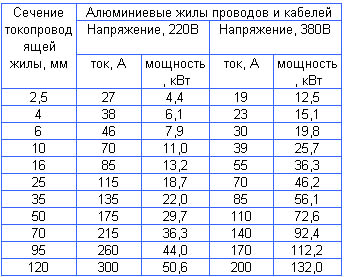
If the permissible current is exceeded, the wires begin to heat up. As the temperature of a metal increases, its resistance to current increases.
Calculating the voltage drop is quite simple:
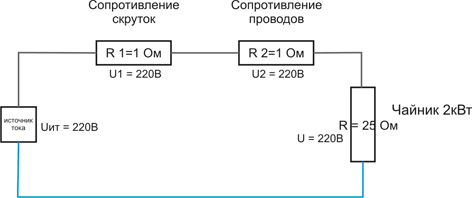
Ohm's law U = I * R
1. I = Uit/(R1+R2+R) = 8.15 A
2. U1 = I * R1 = 8.15 V
3. U2 = I * R2 = 8.15 V
4. U = I * R = 203 IN
As we see the fall voltage due to twists and wire resistance, in this case it was 16.3 V. The resistance of twists depends on their quality and quantity. The resistance of the wires depends on the temperature and its length.
Resistivity copper at 20° - ρ = 0.018 Ohm*mm 2 /m
Specific resistance of aluminum at 20° - 0.028 Ohm*mm 2 /m
Let's get the resistance of the wire from the transformer substation to the consumer. Aluminum wire cross-section 16 mm 2, distance 1 km.
Wire resistance R = 0.028 * 1000 / 16 = 1.75 Ohm
Taking into account the fact that the output voltage at the TP is set to 240V - 260V, then even if you are 2 km away from it, a normal voltage of 220V reaches you if all wire connections are made efficiently. But as soon as the network is overloaded, the resistance of the wires increases sharply. This is especially noticeable in holiday villages, where there are low-power transformer substations and a huge number of consumers. During the day, the voltage in the network can drop to 100V for end consumers, and at night it can rise to 260V.
For devices where available electronic circuits such tension is destructive. For modern electric motors, pumps, compressors, refrigerators, such voltage is also not acceptable. In order to save materials, they are designed for a voltage of 220-230V ± 5%, without a double safety margin, as before. And under conditions of poor voltage they simply burn out.
In particularly dire situations, even a voltage stabilizer will not help.
Let's figure out why the network voltage drops. You've probably noticed more than once when the light dims, especially incandescent lamps, or when an electric kettle takes longer to boil than usual. This is caused by low mains voltage. Usually they say that one of the neighbors turned on a powerful load, such as a welding machine. To better understand the essence of this phenomenon, consider the diagram (Fig. 1) with power supply U ip = 9 V to the terminals 1-2 which an adjustable resistor (potentiometer) is connected, the resistance of which is set 10 ohm .
Rice. 1 – Diagram explaining the operation of an ideal voltage source
The load current Iн, which flows through the resistor Rн, is determined by Ohm's law and is equal to

Let's take a closer look at the diagram again (Fig. 1) No matter how the load resistance changes R n terminal voltage 1-2 to which the load is connected will always be equal to the voltage of the power source U 12 = U SP . Only the load current will change I n proportional to the change in load resistance R n . Thus, the resistance across the load does not depend on the size of the load itself, and the power source itself is an ideal voltage source. If such sources existed in nature, then the voltage would never drop, even in the event of a short circuit.
Now let's look at the processes in a real voltage source. A real voltage source differs from an ideal one in the presence of internal resistance R vn (Fig. 2) .

Rice. 2 – Designation of real and ideal voltage sources
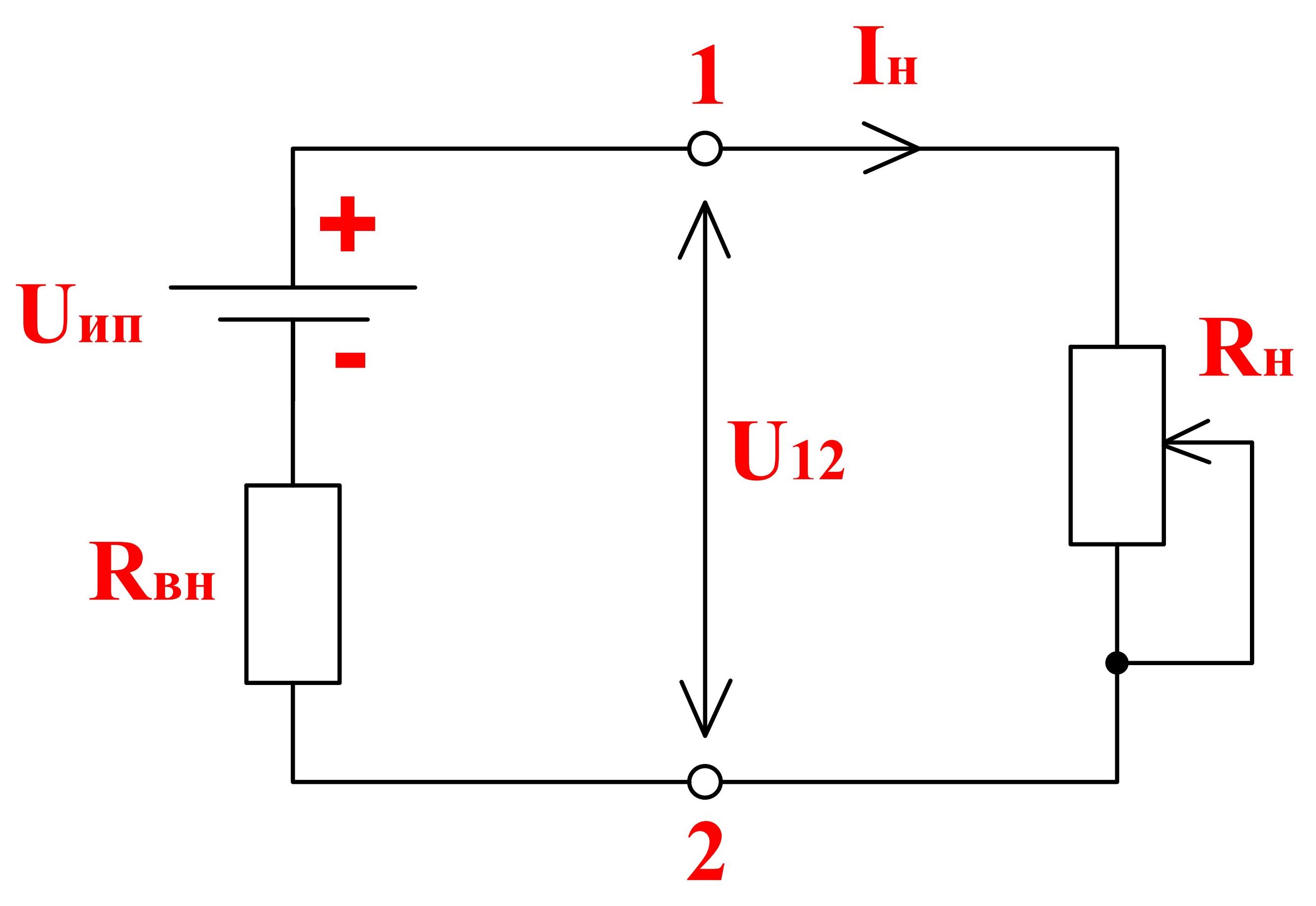
Rice. 3 – Scheme c real source voltage
The value of the internal resistance of the voltage source is of little importance and is often neglected in practice. The lower the internal resistance, the more the real source is close in its properties to the ideal one.
It should be noted that at idle the voltage at the terminals U 12 always equal to the power supply voltage U SP regardless of the value of internal resistance R vn (Fig. 4) . This is explained by the fact that when the circuit is open, no current flows in it and therefore there is no voltage drop across the internal resistance.

Rice. 4 – Diagram of a real power supply at idle
Now let's connect the load to the terminals 1-2 (Fig. 5) and let's see how the voltage changes on them.
The value of internal resistance is taken equal to 1 ohm , and the load resistance 10 Ohm (Fig. 5) .
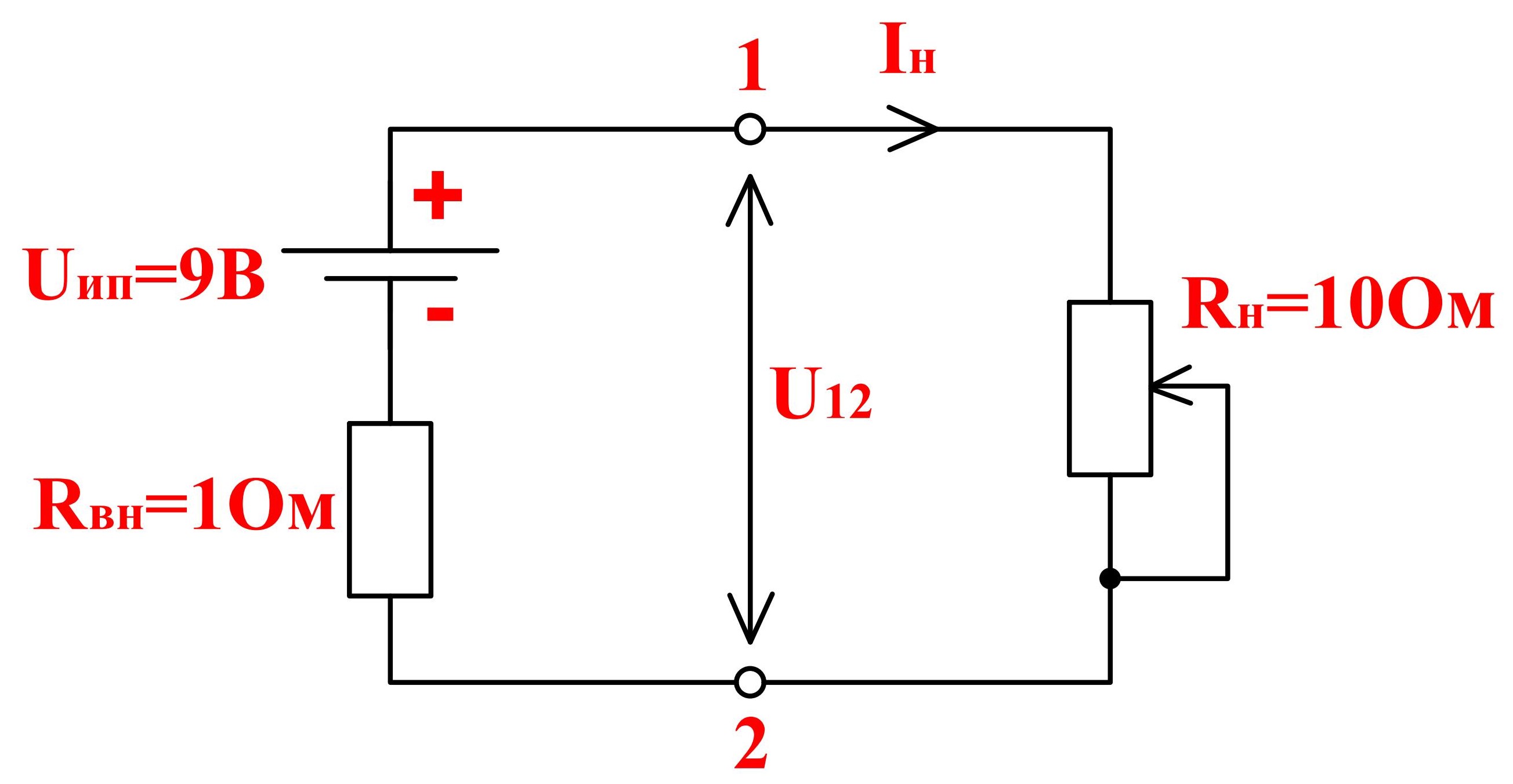
Rice. 5 – Circuit with a real power supply and a 10 Ohm load
Let's determine the load current using Ohm's law

Now let's find the voltage at the load, i.e. at terminals 1-2 of U12. It is determined according to Kirchhoff’s II law:
As you can see, with a load connected equal to 10 ohm , the voltage drops to 0.8 V (Fig. 6) .

Rice. 6 – Load voltage drop distribution diagram
Now we increase the load so that its resistance is equal to the internal resistance of the power source R n = R vn = 1 Ohm (Fig. 7) .

Rice. 7 – Circuit with real power supply and 1 Ohm load
In equals
The voltage drop across the internal resistance is:
Voltage at the load, same as at the terminals 1-2 equals
That is, the voltage dropped by 2 times (Fig. 8) !
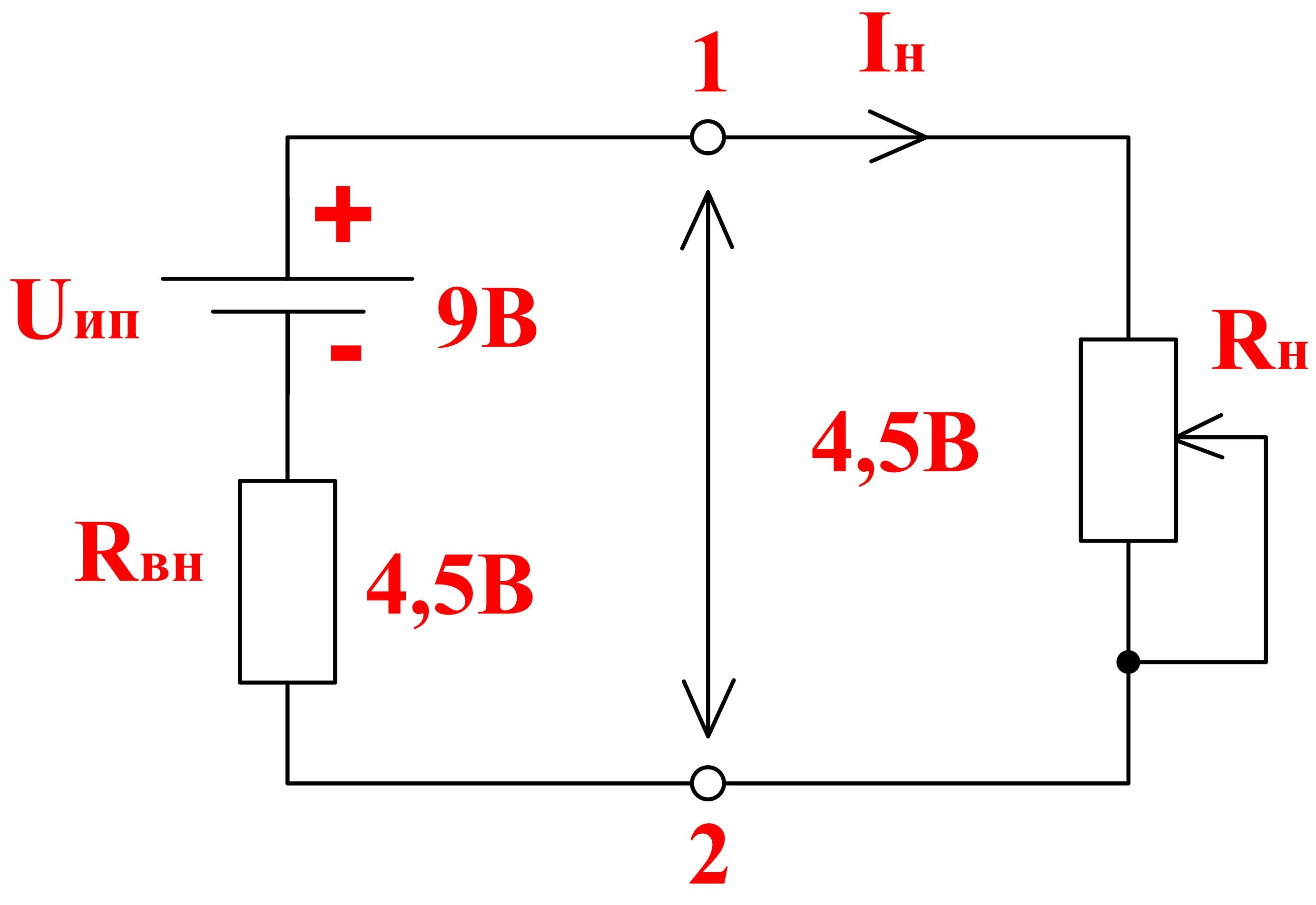
Rice. 8 – Load voltage drop distribution diagram
From this we can draw the following conclusion: as the load increases, the voltage drop across the internal resistance of the voltage source increases, as a result of which the voltage across the load decreases.
Why does the voltage drop in the 220 V, 50 Hz network?
Similar processes occur in a 220 V, 50 Hz network. Only the primary source of voltage is not a socket, but a substation, i.e. a transformer, and you and your neighbors are powered in parallel from its secondary windings (Fig. 9) .
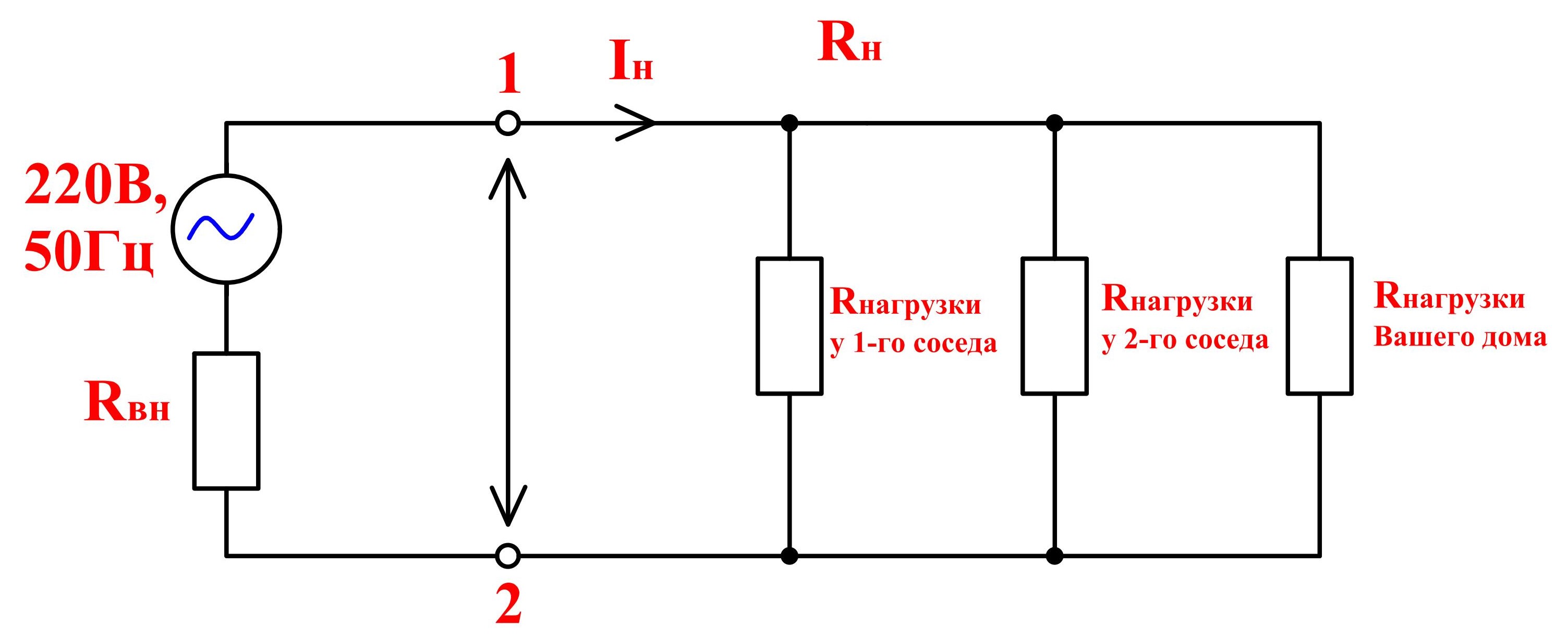
Rice. 9 – Simplified power supply circuit for power frequency consumers
Therefore, if you increase the load, the voltage will drop not only for you, but also for your neighbors. Or when a neighbor connects a high-power load, the voltage will drop for both him and you.
To verify what is said above, you can do a little experiment, for which you will need a power source (any battery or crown), a voltmeter (multimeter) and several resistances of different values.
First, measure the crown voltage at idle (Fig. 10) . As can be seen from the figure, it is equal to 8.50 V (the crown is already a little shrunk).

Now let's connect a resistor to the crown with a resistance 10 kOhm (Fig. 11) . As you can see, the power supply voltage has already dropped a little and is equal to 8.12 V .
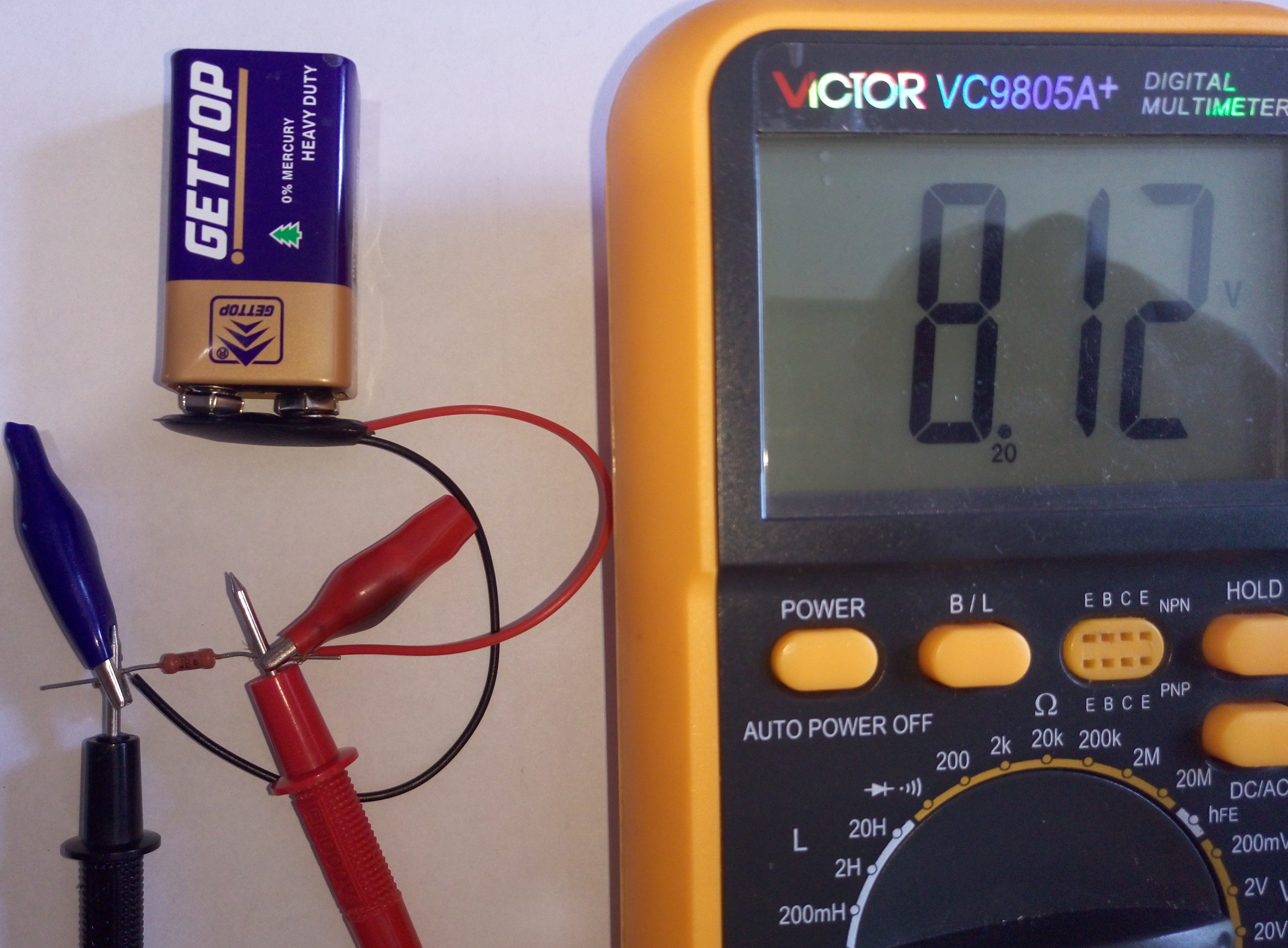
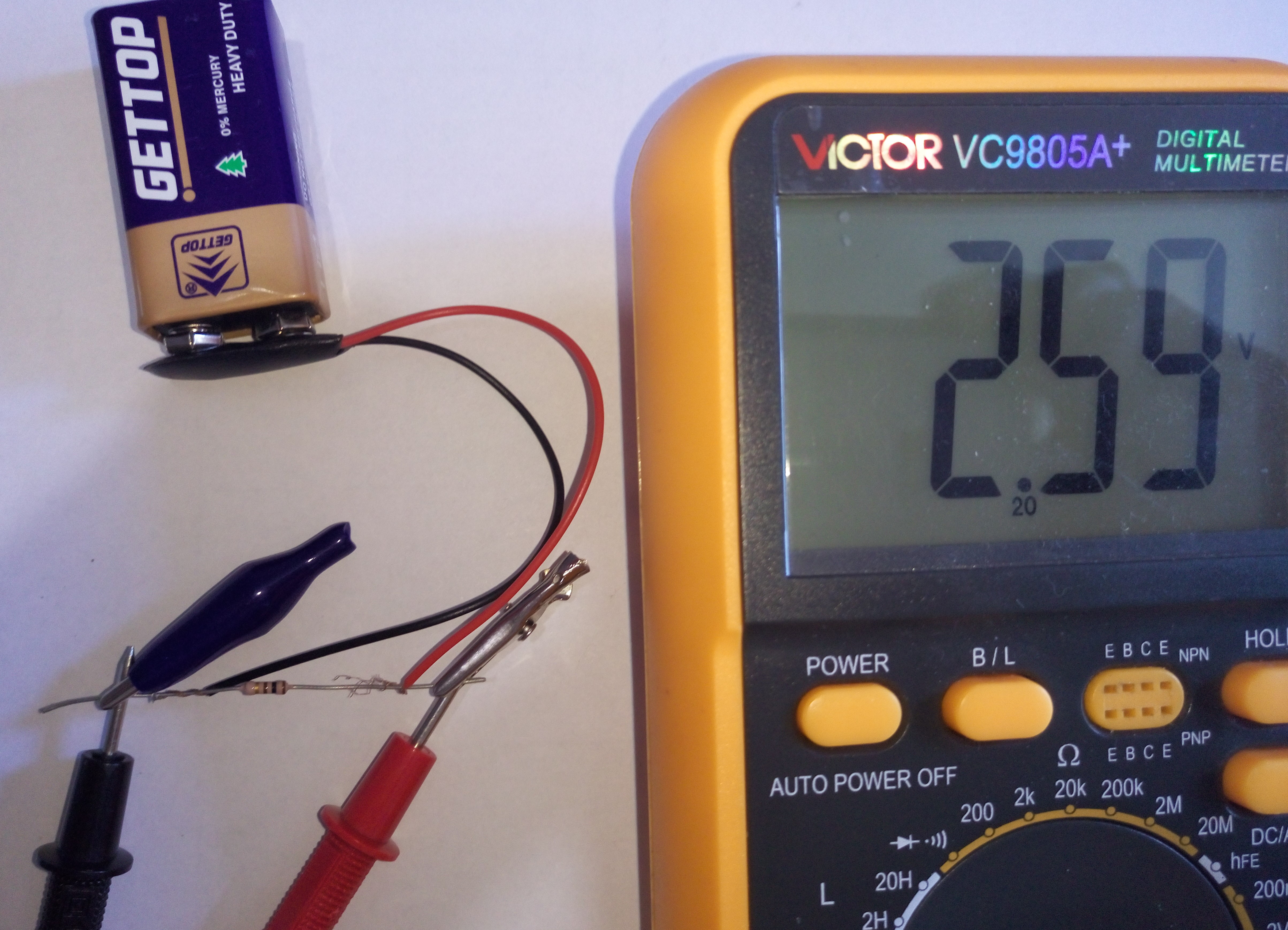
The more discharged the battery, the more the voltage will drop when connecting the same load.
As we have seen, practice completely coincides with theory. Such simple experiments provide a deep understanding of the basic processes occurring in both electrical and electronics, which will make it easier to master more complex material in the future. Now you understand why the voltage in the network drops.
Go to page.




